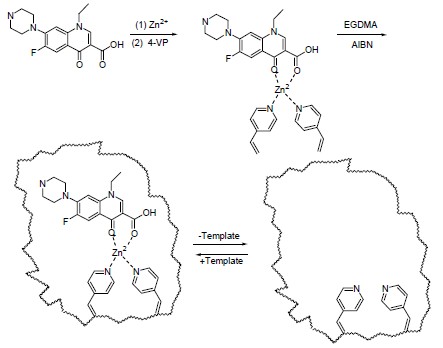[1] Alexander, C.; Davidson, L.; Hayes, W. Tetrahedron 2003, 59(12), 2025.
[2] Alexander, C.; Andersson, H. S.; Andersson, L. I.; Ansell, R. J.; Kirsch, N.; Nicholls, I. A.; O'Mahony, J.; Whitcombe, M. J. J. Mol. Recognit. 2006, 19(2), 106.
[3] Masque, N.; Marce, R. M.; Borrull, F. TrAC, Trends Anal. Chem. 2001, 20(9), 477.
[4] Apodaca, D. C.; Pernites, R. B.; Ponnapati, R.; Del Mundo, F. R.; Advincula, R. C. Macromolecules 2011, 44(17), 6669.
[5] Chen, Y. X.; Gao, B. J.; Jiang, G. M.; Zhang, R. X. Acta Chim. Sinica 2011, 69(14), 1705. (陈迎鑫, 高保娇, 姜桂明, 张瑞霞, 化学学报, 2011, 69(14), 1705.)
[6] Gupta, R.; Kumar, A. J. Sol-Gel Sci. Technol. 2011, 58(1), 182.
[7] Li, D.; Gao, B. J.; Xu, W. M. Acta Chim. Sinica 2011, 69(24), 3019. (李丁, 高保娇, 许文梅, 化学学报, 2011, 69(24), 3019.)
[8] Chen, L. X.; Xu, S. F.; Li, J. H. Chem. Soc. Rev.2011, 40(5), 2922.
[9] Vasapollo, G.; Del Sole, R.; Mergola, L.; Lazzoi, M. R.; Scardino, A.; Scorrano, S.; Mele, G. Int. J. Mol. Sci. 2011, 12(9), 5908.
[10] Long, Y. Y.; Philip, J. Y. N.; Schillen, K.; Liu, F.; Ye, L. J. Mol. Recognit.2011, 24(4), 619.
[11] Zhu, G. F.; Gao, Y. B.; Gao, X.; Fan, J. Acta Chim. Sinica 2011, 69(8), 973. (朱桂芬, 高燕哺, 高霞, 樊静, 化学学报,2011, 69(8), 973.)
[12] Mohajeri, S. A.; Karimi, G.; Aghamohammadian, J.; Khansari, M. R. J. Appl. Polym. Sci. 2011, 121(6), 3590.
[13] Akperov, O. H.; Maharramov, A. M.; Akperov, E. O.; Kadimova, H. A. Iran. Polym. J. 2010, 19(9), 717.
[14] Bagheri, B.; Abdouss, M.; Aslzadeh, M. M.; Shoushtari, A. M. Iran. Polym. J. 2010, 19(12), 911.
[15] Wang, X. H.; Chen, L. R.; Xu, X. J.; Li, Y. Z. Anal. Bioanal. Chem.2011, 401(4), 1423.
[16] Yang, W. H.; Yan, S. L.; Wei, C.; Wang, Q. Z. Acta Polym. Sinica 2010, (10), 1163. (杨卫海, 严守雷, 卫晨, 王清章, 高分子学报, 2010, (10), 1163.)
[17] Azimi, O.; Salari, H.; Emami, Z.; Chamani, J. Eur. Biophys. J. Biophys. Lett.2011, 40, 38.
[18] Bel'tyukova, S. V.; Malinka, E. V.; Liventsova, E. O. J. Water Chem. Technol.2008, 30(1), 38.
[19] Conkle, J. L.; Lattao, C. V.; White, J. R.; Cook, R. L. Anal. Lett.2009, 42(18), 2937.
[20] Khallow, K. I.; Al-Assaf, A. Y. R. E-Journal of Chemistry 2011, 8(2), 576.
[21] Refat, M. S.; Mohamed, G. G.; de Farias, R. F.; Powell, A. K.; El-Garib, M. S.; El-Korashy, S. A.; Hussien, M. A. J. Therm. Anal. Calorim.2010, 102(1), 225.
[22] Gautam, L.; Scott, K. S.; Cole, M. D. J. Anal. Toxicol. 2005, 29(5), 339.
[23] Elghobashi, N.; Gonzalez, L.; Manz, J. Zeitschrift Fur Physikalische Chemie-International Journal of Research in Physical Chemistry & Chemical Physics 2003, 217(12), 1577.
[24] Zhang, M. S.; Huang, J. R.; Tang, L. P. Acta Chim. Sinica 2009, 67(24), 2840. (张茂升, 黄佳蓉, 唐丽萍, 化学学报, 2009, 67(24), 2840.)


